Pete, Bitter bean tree
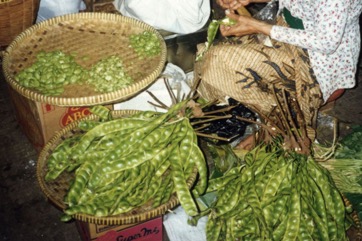
A tropical plant. It is native to SE Asia. They grow in lowland rainforest. It suits a humid climate. They are mostly between sea level and 900 m altitude. It suits hardiness zones 11-12.
Also known as:
Betar, Chou dou,Cong dou, Nejire-fusamame, Nitta tree, Nyiring, Patag, Patai, Petah, Petai, Pete, Peteh, Peuteuy, Pohon petai, Sataw, Sato, Sator dan, Sator kow, Sindutan, U'pang
Synonyms
- Inga pyriformis Jungh.
- Mimosa pedunculata Hunter
- Parkia biglobosa auct. non (Jacq.) R. Br.
- Parkia harbesonii Elmer
- Parka macrocarpa Miq.
Edible Portion
- Seeds, Leaves, Pods, Fruit
Where does Pete grow?
Found in: Asia, Australia, Hawaii, India, Indochina, Indonesia, Laos, Malaysia, Myanmar, Northeastern India, Pacific, Philippines, Sarawak, SE Asia, Singapore, Thailand, United States
Notes: Also as Mimosaceae. The seeds are high in folates. Fruit are high in folates 100μg/100.
Status: Popular and common in Indonesia and Malaysia as a cultivated tree and market food.
Growing Pete, Bitter bean tree
Cultivation: Plants are grown from seeds.
Edible Uses: The seeds are used as flavouring stews. Dried seeds are peeled and fried in oil. Young pods are eaten cooked as a vegetable. They are eaten with poultry, fish or stir-fried vegetable dishes. Young seeds can be eaten pickled, raw or cooked. They are roasted, boiled or added to soups. Young leaves are also eaten raw. They are packed in brine. The receptacle around the flowers is cut into slices and eaten raw.
Production: Trees first flower when about 15 m high.
Nutrition Info
per 100g edible portion| Edible Part | Energy (kcal) | Protein (g) | Iron (mg) | Vitamin A (ug) | Vitamin c (mg) | Zinc (mg) | % Water |
|---|---|---|---|---|---|---|---|
| Pods | 130 | 8 | 0.7 | - | - | - | 70.7 |
Pete, Bitter bean tree Photos

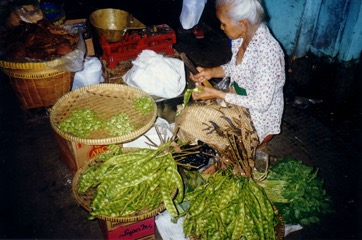
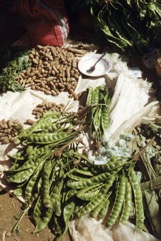
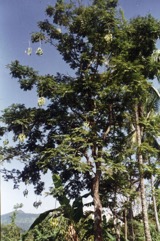
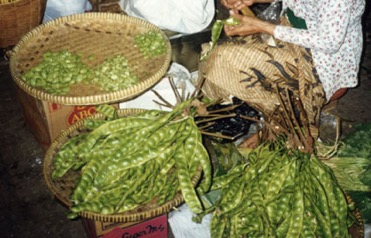
References
Altschul, S.V.R., 1973, Drugs and Foods from Little-known Plants. Notes in Harvard University Herbaria. Harvard Univ. Press. Massachusetts. no. 1649
Argent, G et al, nd, Manual of the Larger and More important non Dipterocarp Trees of Central Kalimantan Indonesia. Volume 2 Forest Research Institute, Samarinda, Indonesia. p 365
Arora, R. K., 2014, Diversity in Underutilized Plant Species - An Asia-Pacific Perspective. Bioversity International. p 50, 107, 129
Barwick, M., 2004, Tropical and Subtropical Trees. A Worldwide Encyclopedic Guide. Thames and Hudson p 310
Burkill, I.H., 1966, A Dictionary of the Economic Products of the Malay Peninsula. Ministry of Agriculture and Cooperatives, Kuala Lumpur, Malaysia. Vol 2 (I-Z) p 1700
Chai, P. P. K. (Ed), et al, 2000, A checklist of Flora, Fauna, Food and Medicinal Plants. Lanjak Entimau Wildlife Sanctuary, Sarawak. Forestry Malaysia & ITTO. p 159
Chin, H. F., 1999, Malaysian Vegetables in Colour. Tropical Press. p 96
Ching, L. S. & Mohamed, S., 2001, Alpha-Tocopherol Content in 62 Edible Tropical Plants. J. Agric. Food Chem. 2001, 49, 3101−3105
Cundall, P., (ed.), 2004, Gardening Australia: flora: the gardener's bible. ABC Books. p 987
Etherington, K., & Imwold, D., (Eds), 2001, Botanica's Trees & Shrubs. The illustrated A-Z of over 8500 trees and shrubs. Random House, Australia. p 511
Facciola, S., 1998, Cornucopia 2: a Source Book of Edible Plants. Kampong Publications, p 153
Flora 25(Beibl. 2):55. 1842
Foo, J.T.S.(ed), 1996, A Guide to Common Vegetables. Singapore Science Foundation. p 88
Food Composition Tables for use in East Asia FAO http://www.fao.org/infoods/directory No. 635
Hanum, F. I., 1999, Plant Diversity and Conservation Value of Ayer Hitam Forest, Selangor, Peninsula Malaysia. Pertanika J. Trop. Agric. Sci. 22(2):73-83
Hariyadi, B., 2008, The Entwined Tree: Traditional Natural Resource Management of Serampas, Jambi, Indonesia. Ph. D thesis. Univ. or Hawaii. p 444
Hopkins, 1992, Flora Malesiana ser 1, 11(1) p 198
Jacquat, C., 1990, Plants from the Markets of Thailand. D.K. Book House p 41
Japanese International Research Centre for Agricultural Science www.jircas.affrc.go.jp/project/value_addition/Vegetables
Jiwajinda, S., et al, 2002, Suppressive Effects of Edible Thai Plants on Superoxide and Nitric Oxide Generation. Asian Pacific Journal of Cancer Prevention, Vol 3, 2002
Kiple, K.F. & Ornelas, K.C., (eds), 2000, The Cambridge World History of Food. CUP p 1829
Lembogi Biologi Nasional, 1980, Sayur-sayuran. Balai Pustaka, Jakarta. p 88
Macmillan, H.F. (Revised Barlow, H.S., et al) 1991, Tropical Planting and Gardening. Sixth edition. Malayan Nature Society. Kuala Lumpur. p 327
Maisuthisakul, P., 2012, Phenolic Constituents and Antioxidant Properties of some Thai Plants. Chp. 9 in Book Phytochemicals - A Global Perspective of Their Role in Nutrition and Health
Martin, F.W. & Ruberte, R.M., 1979, Edible Leaves of the Tropics. Antillian College Press, Mayaguez, Puerto Rico. p 200
Martin, F. W., et al, 1987, Perennial Edible Fruits of the Tropics. USDA Handbook 642 p 35
McMakin, P.D., 2000, Flowering Plants of Thailand. A Field Guide. White Lotus. p 53
Menninger, E.A., 1977, Edible Nuts of the World. Horticultural Books. Florida p 98
Nakahara, K. et al, 2002, Antimutagenicity of Some Edible Thai Plants, and a Bioactive Carbazole Alkaloid, Mahanine, Isolated from Micromelum minutum. Journal of Agricultural and Food Chemistry. 50: 4796-4892
Neilsen, 1992, Flora Malesiana ser 1 Vol 11(1) p 198
Ochse, J.J. et al, 1931, Vegetables of the Dutch East Indies. Asher reprint. p 404
Ong, H., et al, 2012, Traditional knowledge and usage of edible plants among the Semai community of Kampung Batu 16, Tapah, Perak, Malaysia. Scientific Research and Essays Vol. 7(4), pp. 441-445, 30 January, 2012
Owen, S., 1993, Indonesian Food and Cookery, INDIRA reprints. p 78
Pawera, L., et al, 2020, Wild Food Plants and Trends in Their Use: From Knowledge and Perceptions to Drivers of Change in West Sumatra, Indonesia, Foods. 2020, 9, 1240
PROSEA handbook Volume 13 Spices. p 279 and p 278 (As Parkia harbesonii)
Sakunpak, A. & Panichayupakaranant, P., 2012, Antibacterial activity of Thai edible plants against gastrointestinal pathogenic bacteria and isolation of a new broad spectrum antibacterial polyisoprenylated benzophenone, chamuangone. Food Chemistry 130 (2012) 826–831
Saw, L.G., LaFrankie, J. V. Kochummen, K. M., Yap S. K., 1991, Fruit Trees in a Malaysian Rain Forest. Economic Botany, Vol. 45, No. 1, pp. 120-136
Siong, K. H., 2003, Indigenous Fruits of Sarawak. ITTO & Sarawak Forest Department. p 78
Slik, F., www.asianplant.net
Solomon, C., 2001, Encyclopedia of Asian Food. New Holland. p 210, 271
Staples, G.W. and Herbst, D.R., 2005, A tropical Garden Flora. Bishop Museum Press, Honolulu, Hawaii. p 334
Striegel, L., et al, 2019, Promising Tropical Fruits High in Folates. Foods 2019, 8, 363; doi:10.3390/foods8090363. www.mdpi.com/journal/foods
Sukarya, D. G., (Ed.) 2013, 3,500 Plant Species of the Botanic Gardens of Indonesia. LIPI p 433
Tanaka,
Terra, G.J.A., 1973, Tropical Vegetables. Communication 54e Royal Tropical Institute, Amsterdam, p 64
Uphof,
USDA, ARS, National Genetic Resources Program. Germplasm Resources Information Network - (GRIN). [Online Database] National Germplasm Resources Laboratory, Beltsville, Maryland. Available: www.ars-grin.gov/cgi-bin/npgs/html/econ.pl (10 April 2000)
van Wyk, B., 2005, Food Plants of the World. An illustrated guide. Timber press. p 278
www.worldagroforestrycentre.org/treedb/
Zawiah, N. & Othaman, H., 2012, 99 Spesies Buah di FRIM. Institut Penyelidikan Perhutanan Malaysia. p 188